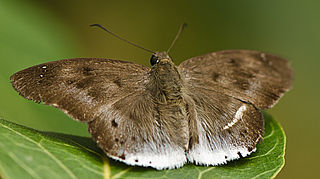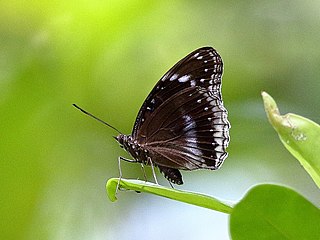
Hypolimnas is a genus of tropical brush-footed butterflies commonly known as eggflies or diadems. The genus contains approximately 23 species, most of which are found in Africa, Asia, and Oceania. One species, the Danaid eggfly, is noted for its exceptionally wide distribution across five continents; it is the only Hypolimnas species found in the Americas.

Leptosia nina, the psyche, is a small butterfly of the family Pieridae and is found in Indian subcontinent, southeast Asia and Australia. The upper forewing has a black spot on a mainly white background. The flight is weak and erratic and the body of the butterfly bobs up and down as it beats its wings. They fly low over the grass and the butterfly rarely leaves the ground level.

Tagiades japetus, commonly known as the pied flat or the common snow flat, is a species of spread-winged skipper butterfly belonging to the family Hesperiidae. It is widely distributed, being found from India, the Himalayas, Southeast Asia, to Australia. It contains several recognized subspecies.

Hypolimnas bolina, the great eggfly, common eggfly, varied eggfly or in New Zealand the blue moon butterfly is a species of nymphalid butterfly found from Madagascar to Asia and Australia.

Graphium doson, the common jay, is a black, tropical papilionid (swallowtail) butterfly with pale blue semi-transparent central wing bands that are formed by large spots. There is a marginal series of smaller spots. The underside of wings is brown with markings similar to upperside but whitish in colour. The sexes look alike. The species was first described by father and son entomologists Cajetan and Rudolf Felder.

Graphium eurypylus, the great jay or pale green triangle, is a species of tropical butterfly belonging to the family Papilionidae.

Zemeros flegyas, the Punchinello, is a small butterfly found in South Asia and Southeast Asia that belongs to the family Riodinidae.

Hebomoia glaucippe, the great orange-tip, is a butterfly belonging to the family Pieridae, that is the yellows and whites. It is found in the Indomalayan realm and Wallacea.

Anthene lycaenina, the pointed ciliate blue, is a small butterfly found in India that belongs to the lycaenids or blues family found in Indomalayan realm. The species was first described by Cajetan Felder in 1868.

Hypolycaena erylus, the common tit, is a small but striking butterfly found in India and South-East Asia that belongs to the lycaenids or blues family. The species was first described by Jean-Baptiste Godart in 1823.

Ypthima baldus, the common five-ring, is a species of Satyrinae butterfly found in Asia.

Doleschallia bisaltide, the autumn leaf, is a nymphalid butterfly found in South Asia, Southeast Asia, and Australasia. In Australia it is also known as the leafwing.

Deudorix epijarbas, the cornelian or hairy line blue, is a species of lycaenid or blue butterfly found in south and southeast Asia from India to Fiji, including the Philippines, and also the tropical coast of Queensland in Australia. The species was first described by Frederic Moore in 1857.

Orsotriaena medus is a butterfly found in south Asia, southeast Asia, and Australia. It is the only species in the genus Orsotriaena, first described by Hans Daniel Johan Wallengren in 1858.

Apaturina is a monotypic genus of butterflies in the family Nymphalidae. Its sole species is Apaturina erminea, the turquoise emperor.

Cethosia biblis, the red lacewing, is a species of heliconiine butterfly belonging to the family Nymphalidae.

Junonia orithya is a nymphalid butterfly with many subspecies occurring from Africa, through southern and south-eastern Asia, Cambodia and in Australia. In India, its common English name is the blue pansy, but in southern Africa it is known as the eyed pansy as the name blue pansy refers to Junonia oenone. In Australia, this butterfly is known as the blue argus, but this name also is used for the Aricia anteros in Europe.

Hypolimnas alimena, the blue-banded eggfly, is a species of butterfly in the family Nymphalidae. It is found in the Solomon Islands, Indonesia, New Guinea and Australia.

Hypolimnas antilope, the spotted crow eggfly, is a butterfly of the family Nymphalidae. It is found from Malaya to the Philippines, New Guinea and Australia.

Euploea phaenareta, the giant crow is a butterfly in the family Nymphalidae. It was described by Johann Gottlieb Schaller in 1785. It is found in the Indomalayan realm and the Australasian realm.





















